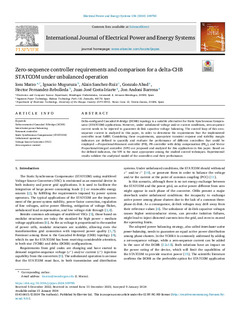Título
Zero-sequence controller requirements and comparison for a delta-CHB STATCOM under unbalanced operationFecha de publicación
2024Grupo de investigación
Sistemas electrónicos de potencia aplicados al control de la energía eléctricaOtras instituciones
Universidad del País Vasco/Euskal Herriko Unibertsitatea (UPV/EHU)Ingeteam (Spain)
Versión
Version publicadaTipo de documento
ArtículoArtículoIdioma
InglésDerechos
© 2024 The AuthorsAcceso
Acceso abiertoVersión de la editorial
https://doi.org/10.1016/j.ijepes.2024.109785Publicado en
International Journal of Electrical Power & Energy Systems Editorial
ElsevierPalabras clave
Delta-connected Cascaded H-Bridge (DCHB)
Intercluster power balancing
Resonant controller
Static Synchronous Compensator (STATCOM) ... [+]
Intercluster power balancing
Resonant controller
Static Synchronous Compensator (STATCOM) ... [+]
Delta-connected Cascaded H-Bridge (DCHB)
Intercluster power balancing
Resonant controller
Static Synchronous Compensator (STATCOM)
unbalanced operation
Voltage Source Converter (VSC)
Zero-sequence current [-]
Intercluster power balancing
Resonant controller
Static Synchronous Compensator (STATCOM)
unbalanced operation
Voltage Source Converter (VSC)
Zero-sequence current [-]
Campo (Clasificación UNESCO)
Ciencias TecnológicasDisciplina (Clasificación UNESCO)
Ingeniería y tecnología eléctricasResumen
Delta-configured Cascaded H-Bridge (DCHB) topology is a suitable alternative for Static Synchronous Compensator (STATCOM) applications. However, under unbalanced voltage and/or current conditions, zer ... [+]
Delta-configured Cascaded H-Bridge (DCHB) topology is a suitable alternative for Static Synchronous Compensator (STATCOM) applications. However, under unbalanced voltage and/or current conditions, zero-sequence current needs to be injected to guarantee dc-link capacitor voltage balancing. The control loop of this zero-sequence current is analyzed in this paper, in order to determine the requirements that the implemented controller must fulfill. Considering these requirements, appropriate transient response and stability margin indicators are defined to quantify and evaluate the performance of different controllers that could be employed —Proportional-Resonant controller (PR), PR controller with delay compensation (PR), and Vector Proportional-Integral controller (VPI) are proposed and analyzed for this application in this paper. Based on the defined indicators, the VPI is the most appropriate among the studied control techniques. Experimental results validate the analytical model of the controllers and their performance. [-]
Colecciones
- Artículos - Ingeniería [758]
El ítem tiene asociados los siguientes ficheros de licencia:






















